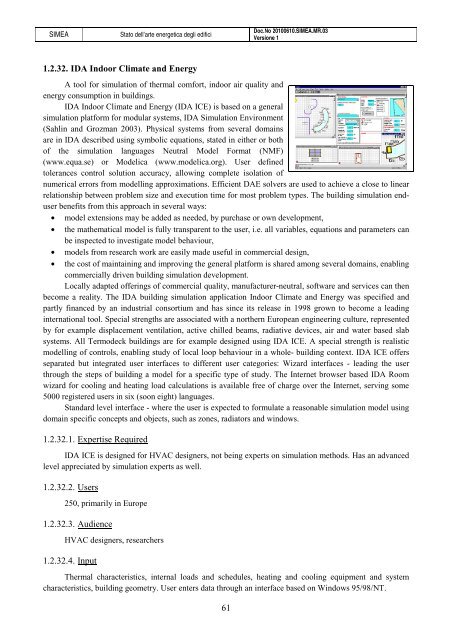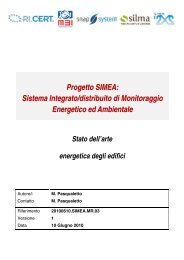Progetto SIMEA - Automatica - Università degli Studi di Padova
Progetto SIMEA - Automatica - Università degli Studi di Padova
Progetto SIMEA - Automatica - Università degli Studi di Padova
Create successful ePaper yourself
Turn your PDF publications into a flip-book with our unique Google optimized e-Paper software.
<strong>SIMEA</strong> Stato dell’arte energetica <strong>degli</strong> e<strong>di</strong>fici<br />
1.2.32. IDA Indoor Climate and Energy<br />
61<br />
Doc.No 20100610.<strong>SIMEA</strong>.MR.03<br />
Versione 1<br />
A tool for simulation of thermal comfort, indoor air quality and<br />
energy consumption in buil<strong>di</strong>ngs.<br />
IDA Indoor Climate and Energy (IDA ICE) is based on a general<br />
simulation platform for modular systems, IDA Simulation Environment<br />
(Sahlin and Grozman 2003). Physical systems from several domains<br />
are in IDA described using symbolic equations, stated in either or both<br />
of the simulation languages Neutral Model Format (NMF)<br />
(www.equa.se) or Modelica (www.modelica.org). User defined<br />
tolerances control solution accuracy, allowing complete isolation of<br />
numerical errors from modelling approximations. Efficient DAE solvers are used to achieve a close to linear<br />
relationship between problem size and execution time for most problem types. The buil<strong>di</strong>ng simulation enduser<br />
benefits from this approach in several ways:<br />
• model extensions may be added as needed, by purchase or own development,<br />
• the mathematical model is fully transparent to the user, i.e. all variables, equations and parameters can<br />
be inspected to investigate model behaviour,<br />
• models from research work are easily made useful in commercial design,<br />
• the cost of maintaining and improving the general platform is shared among several domains, enabling<br />
commercially driven buil<strong>di</strong>ng simulation development.<br />
Locally adapted offerings of commercial quality, manufacturer-neutral, software and services can then<br />
become a reality. The IDA buil<strong>di</strong>ng simulation application Indoor Climate and Energy was specified and<br />
partly financed by an industrial consortium and has since its release in 1998 grown to become a lea<strong>di</strong>ng<br />
international tool. Special strengths are associated with a northern European engineering culture, represented<br />
by for example <strong>di</strong>splacement ventilation, active chilled beams, ra<strong>di</strong>ative devices, air and water based slab<br />
systems. All Termodeck buil<strong>di</strong>ngs are for example designed using IDA ICE. A special strength is realistic<br />
modelling of controls, enabling study of local loop behaviour in a whole- buil<strong>di</strong>ng context. IDA ICE offers<br />
separated but integrated user interfaces to <strong>di</strong>fferent user categories: Wizard interfaces - lea<strong>di</strong>ng the user<br />
through the steps of buil<strong>di</strong>ng a model for a specific type of study. The Internet browser based IDA Room<br />
wizard for cooling and heating load calculations is available free of charge over the Internet, serving some<br />
5000 registered users in six (soon eight) languages.<br />
Standard level interface - where the user is expected to formulate a reasonable simulation model using<br />
domain specific concepts and objects, such as zones, ra<strong>di</strong>ators and windows.<br />
1.2.32.1. Expertise Required<br />
IDA ICE is designed for HVAC designers, not being experts on simulation methods. Has an advanced<br />
level appreciated by simulation experts as well.<br />
1.2.32.2. Users<br />
250, primarily in Europe<br />
1.2.32.3. Au<strong>di</strong>ence<br />
HVAC designers, researchers<br />
1.2.32.4. Input<br />
Thermal characteristics, internal loads and schedules, heating and cooling equipment and system<br />
characteristics, buil<strong>di</strong>ng geometry. User enters data through an interface based on Windows 95/98/NT.
















